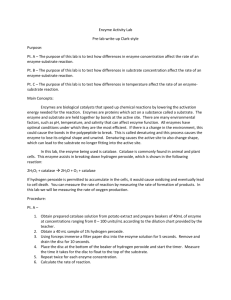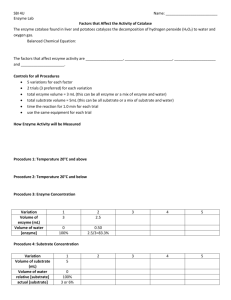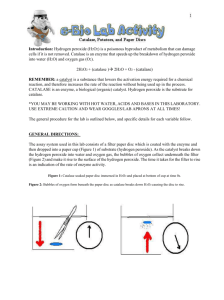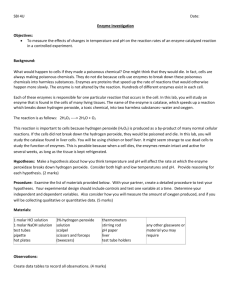AP Biology LAB 2 ENZYME CATALYSIS
advertisement
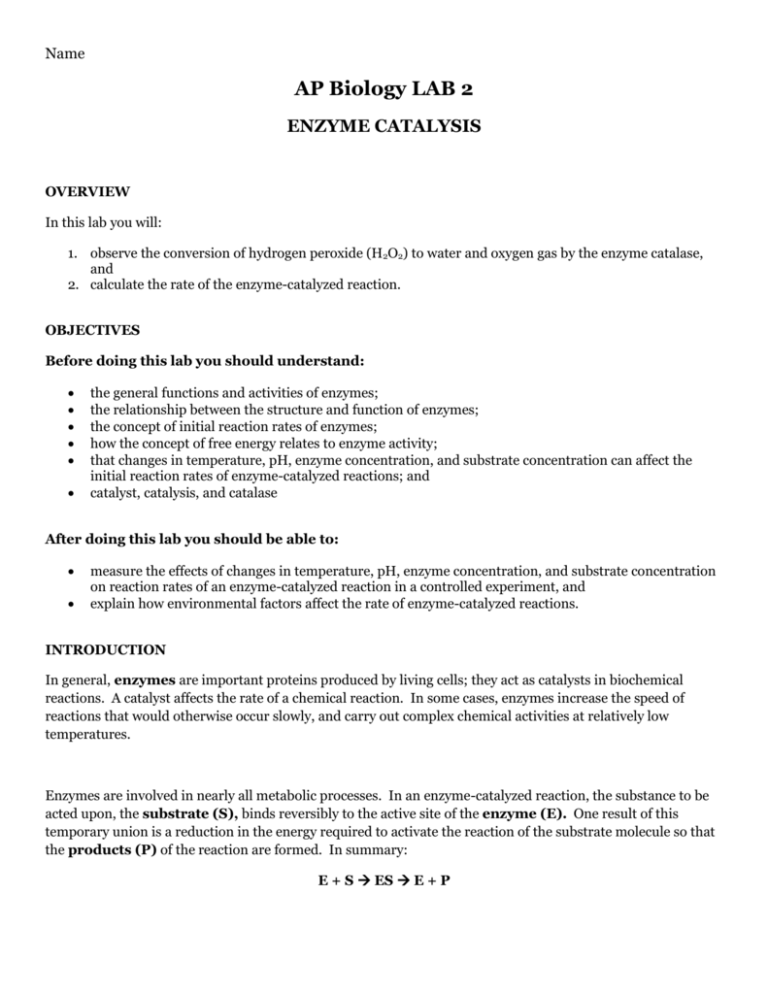
Name AP Biology LAB 2 ENZYME CATALYSIS OVERVIEW In this lab you will: 1. observe the conversion of hydrogen peroxide (H2O2) to water and oxygen gas by the enzyme catalase, and 2. calculate the rate of the enzyme-catalyzed reaction. OBJECTIVES Before doing this lab you should understand: the general functions and activities of enzymes; the relationship between the structure and function of enzymes; the concept of initial reaction rates of enzymes; how the concept of free energy relates to enzyme activity; that changes in temperature, pH, enzyme concentration, and substrate concentration can affect the initial reaction rates of enzyme-catalyzed reactions; and catalyst, catalysis, and catalase After doing this lab you should be able to: measure the effects of changes in temperature, pH, enzyme concentration, and substrate concentration on reaction rates of an enzyme-catalyzed reaction in a controlled experiment, and explain how environmental factors affect the rate of enzyme-catalyzed reactions. INTRODUCTION In general, enzymes are important proteins produced by living cells; they act as catalysts in biochemical reactions. A catalyst affects the rate of a chemical reaction. In some cases, enzymes increase the speed of reactions that would otherwise occur slowly, and carry out complex chemical activities at relatively low temperatures. Enzymes are involved in nearly all metabolic processes. In an enzyme-catalyzed reaction, the substance to be acted upon, the substrate (S), binds reversibly to the active site of the enzyme (E). One result of this temporary union is a reduction in the energy required to activate the reaction of the substrate molecule so that the products (P) of the reaction are formed. In summary: E + S ES E + P Note that the enzyme is not changed in the reaction and can be recycled to break down additional substrate molecules. Each enzyme is specific for a particular reaction because its amino acid sequence is unique and causes it to have a unique three-dimensional structure. The active site is the portion of the enzyme that interacts with the substrate, so that any substance that blocks or changes the shape of the active site affects the activity of the enzyme. A description of several ways enzyme action may be affected follows: 1. Salt Concentration. If the salt concentration is close to zero, the charged amino acid side chains of the enzyme molecules will attract each other. The enzyme will denature and form an inactive precipitate. If, on the other hand, the salt concentration is very high, normal interaction of charged groups will be blocked, new interactions will occur, and again the enzyme will precipitate. An intermediate salt concentration, such as that of human blood (0.9%) or cytoplasm, is the optimum for many enzymes. 2. pH. pH is a logarithmic scale that measures the acidity, or H+ concentration, in a solution. The scale runs from 0 to 14 with 0 being the highest in acidity and 14 the lowest. When the pH is in the range of 0-7, a solution is said to be acidic; if the pH is around 7, the solution is neutral; and if the pH is in the range of 7-14, the solution is basic. Amino acid side chains contain groups, such as –COOH and –NH2, that readily gain or lose H+ ions, As the pH is lowered an enzyme will tend to gain H+ ions, and eventually enough side chains will be affected so that the enzyme’s shape is disrupted. Likewise, as the pH is raised, the enzyme will lose H+ ions and eventually lose its active shape. Many enzymes perform optimally in the neutral pH range and are denatured at either an extremely high or low pH. Some enzymes, such as pepsin, which acts in the human stomach where the pH is very low, have a low pH optimum. 3. Temperature. Generally, chemical reactions speed up as the temperature is raised. As the temperature increases, more of the reacting molecules have enough kinetic energy to undergo the reaction. Since enzymes are catalysts for chemical reactions, enzyme reactions also tend to go faster with increasing temperature. However, if the temperature of an enzyme-catalyzed reaction is raised still further, a temperature optimum is reached; above this value the kinetic energy of the enzyme and water molecules is so great that the conformation of the enzyme molecules is disrupted. The positive effect of speeding up the reaction is now more than offset by the negative effect of changing the conformation of more and more enzyme molecules. Many proteins are denatured by temperatures around 40-50oC, but some are still active at 70-80oC, and a few even withstand boiling. 4. Activation and Inhibitors. Many molecules other than the substrate may interact with an enzyme. If such a molecule increases the rate of the reaction it is an activator; and if it decreases the reaction rate it is an inhibitor. These molecules can regulate how fast the enzyme acts. Any substance that tends to unfold the enzyme, such as an organic solvent or detergent, will act as an inhibitor. Some inhibitors act by reducing the –S-S bridges that stabilize the enzyme’s structure. Many inhibitors act by reacting with side chains in or near the active site to change its shape or block it. Many well-known poisons, such as potassium cyanide and curare, are enzyme inhibitors that interfere with the active site of critical enzymes. The enzyme used in this lab, catalase, has four polypeptide chains, each composed of more that 500 amino acids. This enzyme is ubiquitous in aerobic organisms. One function of catalase within cells is to prevent the accumulation of toxic levels of hydrogen peroxide (H2O2) formed as a byproduct of metabolic processes. Catalase might also take part is some of the many oxidation reactions that occur in all cells. Catalase speeds up the breakdown of hydrogen peroxide into water (H2O) and oxygen gas (O2). The chemical equation for this reaction is as follows: 2H2O2 (catalase) 2H2O + O2 (+ catalase) In the absence of catalase, this reaction occurs spontaneously but very slowly. Catalase speeds up the reaction considerably. In this experiment, a rate for this reaction will be determined. Name AP LAB 2: ENZYME CATALYSIS STUDENT PROCEDURE Label the enzyme, substrate, product A, and product B below specifically for this lab. Enzyme: ___________________ Substrate __________________ Product A: ________________ Product B: _________________ Test 1: CHANGE IN ENZYME CONCENTRATION…..to see what happens when you have a substrate, and the amount of enzyme changes. 1. Obtain 4 test tubes and label with post its: 100%, 50%, 25%, and 0%. 2. Prepare 20 ml of enzyme for each of the above concentrations by using the following volumes in the table below. You will use a graduated cylinder to measure the volumes. Catalase enzyme stock (prepared by Mrs. B) *20 ml 10 ml 5 ml 0 ml cold water Percentage (%) 0 ml 10 ml 15 ml 20 ml 100 50 25 0 *you will save the undiluted enzyme (100 %) for Test 2 3. 4. 5. 6. 7. 8. 9. 10. 11. Obtain 2 test tubes for the substrate (hydrogen peroxide). Place 25 ml of 3% hydrogen peroxide solution into each test tube. Use a hole punch to punch out 2 filter punches from a coffee filter. Using forceps, immerse both filter punches in the 100% catalase enzyme solution for 5 seconds (use a timer). Keep them separated so they don’t stick to each other. After 5 seconds of immersion in the enzyme, remove the filters and drain by touching the edge to a paper towel for 10 seconds. The filter punches now have 100% catalase on it. Drop the punches (1 in each tube) that has 25 ml of 3% hydrogen peroxide making sure that it rests on the bottom of the cup (use a stirring rod to push it down if necessary). Start the timer when it touches the bottom. In Table 1, record the time it takes for the disc to float to the top of the substrate (hydrogen peroxide) solution. Set aside the test tubes that have the used substrate (hydrogen peroxide) Repeat steps 3-10 for the other filter disk to obtain a total of 2 trials for each change in enzyme concentration. Do not reuse the hydrogen peroxide. (NOTE: Set aside the 100% catalase test tube to use later in the lab). Now you are dipping disks into 50%, 25%, and 0% catalase solutions and performing 2 trials for each and keeping the concentration of the substrate the same (3% hydrogen peroxide). 12. Clean up by dumping everything EXCEPT the test tube that has 100% catalase in it (which you should have already set aside). 13. Graph the data using averages. Test 1 of the lab asks you to test the effect of enzyme concentration on enzyme activity. The enzyme concentration will change, while the substrate concentration is kept constant. State your hypothesis: TABLE 1: Enzyme concentration (%) Disk 1 Floating Time (sec) Disk 2 Floating Time (sec) Average Floating Time (sec) 100 50 25 0 Test 2: CHANGE IN SUBSTRATE CONCENTRATION…..to see what happens when you have the same enzyme concentration, and the amount of substrate changes. Reminder: The substrate in the lab is ______________________________. 1. 2. 3. 4. 5. 6. 7. 8. 9. 10. Obtain 8 test tubes and label with post its (2 of each): 0%, 3%, 10%, and 30% hydrogen peroxide. Place 25 ml of the substrate (hydrogen peroxide) into the appropriately labeled test tubes. Use a hole punch to punch out 2 filter punches from a coffee filter. Using forceps, immerse both filter punches in the 100% catalase enzyme solution for 5 seconds (that you saved from test 1). Keep them separated so they don’t stick to each other. After 5 seconds of immersion in the enzyme, remove the filter and drain by touching the edges to a paper towel for 10 seconds. The filter punches now have 25% catalase on it. Drop the punches (1 in each test tube) into the 100mL of 0% hydrogen peroxide making sure that they rest on the bottom of the tube. Use a stirring rod to push down if necessary. Start the timer when it touches the bottom. In Table 1, record the time it takes for each disc to float to the top of the substrate (hydrogen peroxide) solution. Repeat this procedure for the 3%, 10%, and 30% substrate (hydrogen peroxide) to see how the change in hydrogen peroxide concentration affects the time to float by using the same concentration (100%) of enzyme. Record all data in Table 2 and be sure to calculate the average time for the two discs in each trial. Graph the data using averages. Test 2 of the lab asks you to test the effect of substrate concentration on enzyme activity. The substrate concentration will change, while the enzyme concentration will remain constant. State your hypothesis: TABLE 2: Substrate concentration (%) Disk 1 Floating Time (sec) Disk 2 Floating Time (sec) Average Floating Time (sec) 0 3 10 30 Test 3: CHANGE IN TEMPERATURE CONCENTRATION…..to see what happens when you have the same enzyme and substrate concentrations, but the temperature changes. Reminder: The substrate in the lab is ______________________________. Reminder: The enzyme in the lab is _______________________________. 1. Label 6 test tubes as follows with post its (2 of each): cold, room temp, and hot. Add 25 mL room temp 3% hydrogen peroxide to them. The hydrogen peroxide temperature is not being tested. The test is to see if catalase holds up when exposed to altered temps. 2. At the side of the room, notice 2 water baths. One is set at a COLD temp and the other is HOT. Both have 100% catalase solutions in them. 3. Use a hole punch to punch out 2 filter punches from a coffee filter. 4. Using forceps, immerse the 2 filter punches in the COLD TEMP catalase enzyme solution for 5 seconds. Separate them with forceps if they stick to one another. 5. After 5 seconds of immersion in the enzyme, remove the filters and drain by touching the edges to a paper towel for 10 seconds. The filter punches now have cold catalase on it. 6. Drop the punches (1 in each tube) into the test tube that has 3% hydrogen peroxide making sure that they rest on the bottom of the cup. Use a stirring rod to push down if necessary. Start the timer when it touches the bottom. 7. In Table 3, record the time it takes for each disc to float to the top of the substrate (hydrogen peroxide) solution. 8. Repeat this procedure for the room temp and hot catalase to see how the change in temperature affects the enzyme’s ability to break hydrogen peroxide down. 9. Record all data in Table 3 and be sure to calculate the average time for the two discs in each trial. 10. Graph the data using averages. Test 3 of the lab asks you to test the effect of temperature on enzyme activity. The temperature the enzyme is exposed to will change, while the enzyme concentration and substrate concentration remain constant. State your hypothesis: TABLE 3: Temperature Catalase was exposed to Cold Room temp Hot Disk 1 Floating Time (sec) Disk 2 Floating Time (sec) Average Floating Time (sec) QUESTIONS and ANALYSIS: 1. How is “enzyme activity” for this lab experiment being measured? Explain. 2. What are the dependent and independent variables in TEST 1? 3. How does enzyme activity vary with enzyme concentration? 4. In Test 1, what is kept constant throughout this test? 5. In Test 1, what variable is being tested? 6. What are the dependent and independent variables in TEST 2? 7. What do you think would happen if you increased the substrate concentration to 50% hydrogen peroxide? Would you see a change in your graph? 8. In Test 2, what is kept constant throughout the experiment? 9. In Test 2, what variable is being tested? 10. Does changing the substrate concentration exhibit the same effect as changing the enzyme concentration? 11. Many enzymes that participate in reactions in the human body work best under normal body temperatures. How is this enzyme derived from potato extract different from an enzyme found in the human body? 12. Assume the following results were obtained. Catalase was exposed to varying concentations of pH. pH Level disc 1 Time (s) disc 2 Average pH 4 pH 6 pH 7 pH 8 pH 9 13. Using the graph paper provided, graph the data shown in #12. 14. What conclusions can you draw on the optimum pH level for the enzyme peroxidase? 15. Would you assume that most all enzymes used in the human body prefer to be in a neutral environment? If not, give an example of where you may find enzymes in the human body that prefer pH’s outside the neutral range.





